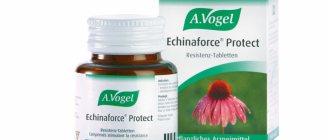Zinforo
When using the drug, you must follow official recommendations for the proper use of antibacterial drugs.
Hypersensitivity reactions
As with all beta-lactam antibiotics, serious reactions are possible.
hypersensitivity (sometimes fatal). Patients with a history of hypersensitivity to cephalosporins, penicillins or other beta-lactam antibiotics may also develop an allergic reaction to ceftaroline fosamil. Before starting drug therapy, the patient's data should be carefully examined to identify hypersensitivity reactions to beta-lactam antibiotics. The drug is contraindicated in patients with a history of hypersensitivity to cephalosporins. The drug is also contraindicated in patients who have previously experienced severe immediate hypersensitivity reactions (eg, anaphylactic reaction) to any other antibacterial agent having a beta-lactam structure (eg, penicillins or carbapenems). If a severe allergic reaction develops, it is necessary to stop administering the drug and take appropriate measures.
Diarrhea associated with Clostridium difficile
With the use of almost all antibacterial drugs, including Zinforo, the development of antibiotic-associated colitis and pseudomembranous colitis has been reported, which can vary in severity from mild to life-threatening forms. The possibility of developing colitis should be taken into account if diarrhea occurs during the use of ceftaroline fosamil. In this case, it is necessary to stop drug therapy, carry out supportive measures and prescribe specific treatment for Clostridium difficile.
Patients with a history of seizures
As with the use of other cephalosporins, in toxicity studies of ceftaroline, the development of seizures was observed when taking the drug in doses exceeding Cmax by 7-25 times. Experience with the use of ceftaroline in patients with a history of seizures is limited, and therefore caution should be exercised when using the drug in this group of patients.
Direct antiglobulin test (Coombs test)
A positive direct antiglobulin test (ELAT) can be obtained during the use of cephalosporins. The rate of positive PAT in patients receiving ceftaroline fosamil 600 mg as an intravenous infusion over 60 minutes every 12 hours was 10.7% in the pooled phase 3 studies and 32.3% in the study using ceftaroline fosamil 600 mg. as an intravenous infusion lasting 120 minutes every 8 hours. Not a single patient with a positive PAT during the use of ceftaroline fosamil showed signs of hemolysis.
Insensitive microorganisms
When using the drug, like other antibiotics, superinfection may develop.
Impact on the ability to drive vehicles and machinery
No studies have been conducted to study the effect of the drug on the ability to drive vehicles and control other mechanisms. During therapy, dizziness may occur, so care should be taken when driving vehicles and when engaging in other potentially hazardous activities that require increased concentration and speed of psychomotor reactions. If the adverse event described above occurs, you should refrain from performing these activities.
Zinforo powder for the preparation of concentrate for infusions 600 mg, 20 ml bottles, 10 pcs.
Zinforo is administered intravenously as an infusion over 60 minutes (see “Preparation of solution for infusion”). The duration of therapy should be determined depending on the type and severity of the infection and the patient's response to therapy. The recommended dosage regimen for adult patients and adolescents aged 12 to 18 years with a body weight of ? 33 kg. Complicated skin and soft tissue infections: 600 mg every 12 hours for 60 minutes for 5-14 days. Community-acquired pneumonia: 600 mg every 12 hours for 60 minutes for 5-7 days. Recommended dosage regimen for children aged 2 months to 12 years and adolescents aged 12 to 18 years weighing <33 kg: - 12 to 18 years, body weight <33 kg: 12 mg/kg1 every 8 hours for 60 minutes. - from 2 to 12 years: 12 mg/kg1 every 8 hours for 60 minutes. - from 2 months to 2 years: 8 mg/kg every 8 hours for 60 minutes. When preparing and administering the drug, standard aseptic rules must be followed. Each bottle is for single use only. Zinforo powder for the preparation of a concentrate for the preparation of a solution for infusion should be dissolved in 20 ml of sterile water for injection. One ml of concentrate contains 30 mg of ceftaroline fosamil. The resulting concentrate is a pale yellow solution, free of visible particles. The concentrate must be used immediately and not stored (the time from the start of dissolution of the powder to the complete preparation of the solution for intravenous infusion should not exceed 30 minutes). To prepare the infusion solution, the resulting concentrate is shaken and transferred to an infusion bottle containing one of the following compatible infusion fluids: 0.9% sodium chloride solution, 5% dextrose solution, 0.45% sodium chloride solution and 2.5% dextrose solution , Ringer's lactate solution. When using a dose of 600 mg of the drug, transfer the entire resulting concentrate (20 ml) into a bottle with a compatible infusion fluid; when using a dose of 400 mg - 14 ml of concentrate. To use a dose of 300 mg, 10 ml of concentrate should be transferred, and for a dose of 200 mg, 7 ml of concentrate should be transferred. An infusion solution can be prepared by adding the concentrate to a 50 ml, 100 ml or 250 ml infusion bottle. The volume of infusion fluid in pediatric patients depends on body weight. The concentration of the solution for infusion during its preparation and administration should not exceed 12 mg/ml ceftaroline fosamil. After preparing the solution for infusion, it should be used within 6 hours of preparation. The prepared solution for infusion remains stable for 24 hours when stored in the refrigerator (2-8°C). After removal from the refrigerator, the infusion solution must be used within 6 hours at room temperature. Unused product or waste must be disposed of in accordance with local regulations.
Zinforo™
Antibiotic of the V generation cephalosporin group (anti-MRSA*-cephepemes).
After IV administration, the prodrug ceftaroline fosamil is rapidly converted to active ceftaroline.
Mechanism of action
Ceftaroline is an antibiotic of the cephalosporin class with in vitro activity against gram-positive and gram-negative microorganisms. The bactericidal effect of ceftaroline leads to inhibition of bacterial cell wall biosynthesis due to binding to penicillin-binding proteins (PBPs). Ceftaroline exhibits bactericidal activity against Staphylococcus aureus due to its high affinity for PSB2a and against Streptococcus pneumoniae due to its high affinity for PSB2x.
Relationship between pharmacokinetics and pharmacodynamics
The antibacterial activity of ceftaroline, as well as other beta-lactam antibiotics, correlates well with the period of time during which drug concentrations remain above the minimum inhibitory concentration (MIC) for the infecting microorganism (%T > MIC).
Mechanism of resistance
Ceftaroline is not active against Enterobacteriaceae strains producing extended-spectrum β-lactamases (ESBLs) of the TEM, SHV or CTX-M families, serine carbapenemases (such as KPC), class B or class C metallo-β-lactamases (AmpC cephalosporinases).
Cross resistance
Despite the possible development of cross-resistance, some strains resistant to other cephalosporins may be sensitive to ceftaroline.
Sensitivity
The prevalence of acquired antibiotic resistance in certain microorganisms may vary across regions and over time. It is recommended to take into account local knowledge of resistance, especially when treating severe infections. If local resistance is such that the effectiveness of the drug against certain infections becomes questionable, expert advice should be sought.
Sensitivity to ceftaroline should be determined using standard methods. Interpretation of results should be carried out in accordance with local guidelines.
Usually susceptible microorganisms: gram-positive microorganisms -
Staphylococcus aureus** (methicillin-sensitive and methicillin-resistant), Streptococcus agalactiae**, Streptococcus anginosus group (includes S. anginosus, S. intermedius and S. constellatus)**, Streptococcus dysgalactiae**, Streptococcus pneumoniae**, Streptococcus pyogenes**;
gram-negative microorganisms -
Haemophilus influenzae**, Haemophilus parainfluenzae**; anaerobes - Fusobacterium spp., Peptostreptococcus spp., Prevotella spp., Propionibacterium acnes.
Microorganisms for which the problem of acquired resistance is relevant: gram-negative microorganisms -
Citrobacter freundii, Citrobacter koseri, Enterobacter aerogenes, Enterobacter cloacae, Escherichia coli**, Klebsiella oxytoca**, Klebsiella pneumoniae**, Morganella morganii**.
Microorganisms with natural resistance:
Chlamydophila spp., Legionella spp., Mycoplasma spp., Pseudomonas aeruginosa.
* methicillin-resistant Staphylococcus aureus ** pathogens for which satisfactory efficacy has been demonstrated in clinical studies.









